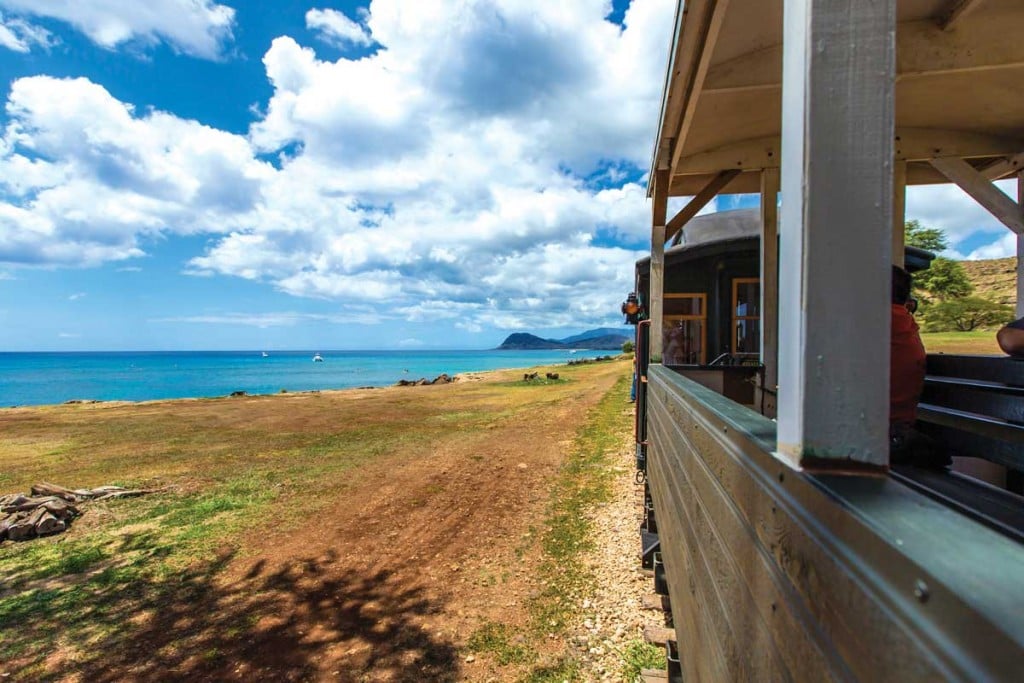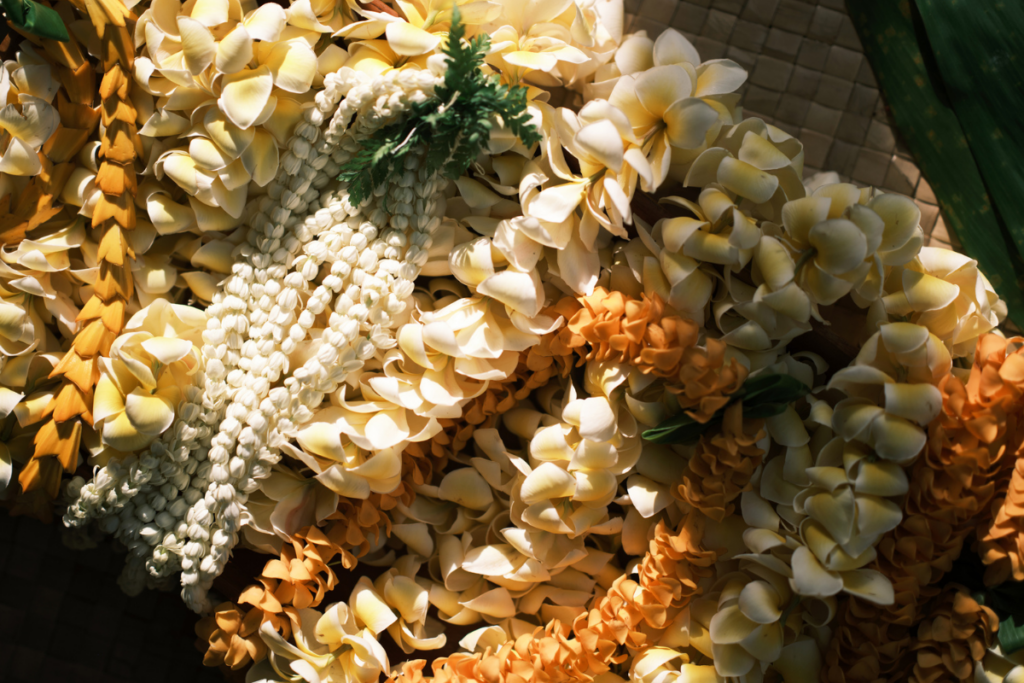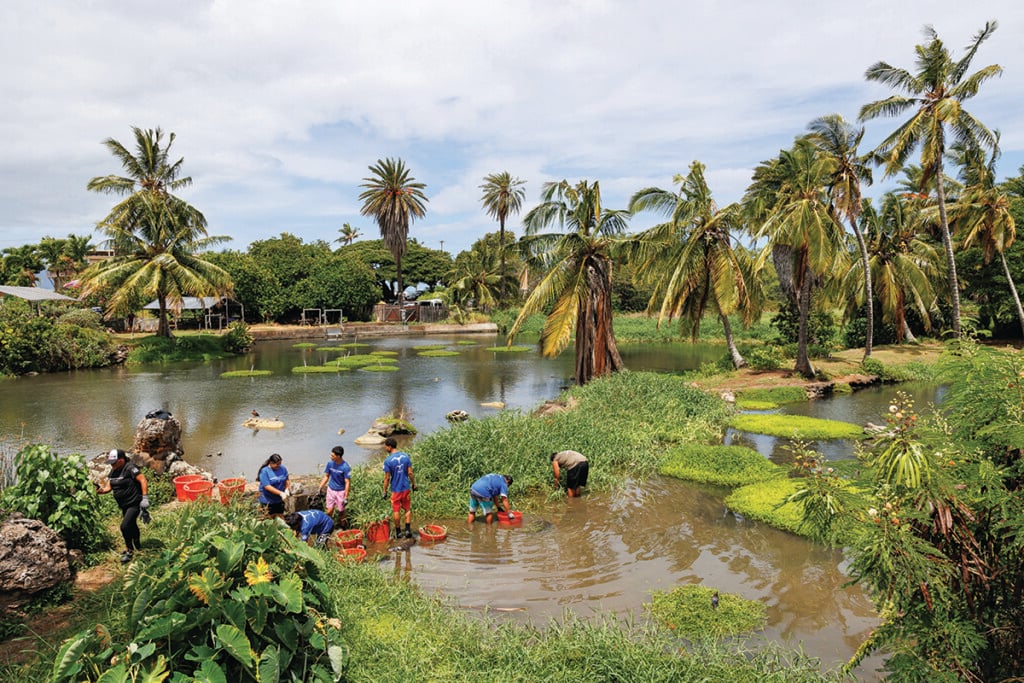A ride through Ewa on Hawaii’s historic Oahu Railway
The Hawaiian Railway Society’s train rides to Kapolei uncover Hawaii’s railroad history and Oahu’s changing landscape.

I took my first train ride when I was 10 years old—an overnight rail trip from Vancouver, B.C., to Banff, Alberta, on a family vacation in Canada.
I’ve long since forgotten the scenery of that 500-plus-mile train ride. But I do recall as clear as yesterday how awed and excited I was when I boarded that behemoth locomotive for the first time. The whistle blasts as it began to move. The bumps, rumbles and screeches as its steel wheels rolled faster and faster on the tracks. I was riding a real train!
The thrill of that first train ride has yet to abate.
So I was eagerly anticipating plans for a recent Sunday afternoon as I headed to the Ewa district, on the plains of Oahu’s southwest tip, for a train ride on tracks restored by the Hawaiian Railway Society (HRS). Rolling along on one of only two remaining stretches of historic track in the Islands (the other is on Kauai), the society’s weekly passenger rides offer an appealing back-in-time glimpse at railroads in Hawaii and the ever-changing landscape of the Ewa district.
“The rides are a fun family activity that helps us raise awareness about the important role railroads played in Hawaii history,” says Jeff Livingston, the nonprofit’s historian. “From track gauges and number plates to boxcars and locomotives, HRS has preserved the last remnants of Oahu’s railroads.”
Hawaii’s railroads were born of agricultural necessity. From the late 1800s to the mid-1950s, trains served as workhorses for the Islands’ then flourishing sugar industry, transporting laborers, cut cane stalks, raw sugar, supplies and equipment between fields and coastal sugar mills. In 1878, Hawaii monarch David Kalakaua signed “An Act to Promote the Construction of Railways,” deeming rail infrastructure “essential to bring produce to safe ports.” The act prompted the founding of seven common rail carriers, among them Oahu Railway & Land Co. (OR&L), founded by visionary Hawaii businessman and industrialist Benjamin Dillingham.
OR&L officially opened for transport on Nov. 16, 1889 (King Kalakaua’s 53rd birthday), with service from downtown Honolulu to the then-countrified burg of Aiea, nine miles west, alongside Pearl Harbor. Some 4,000 people took up Dillingham’s offer of free round-trip rides on opening day.
Over the next half-century, OR&L greatly expanded its routes, carrying freight and passengers on main lines radiating from metro Honolulu to the plantation communities of Aiea, Waipahu, Ewa, Wahiawa, Waianae, Waialua and Kahuku. Rail’s status as a preferred mode of ground transportation remained unchallenged until the conclusion of World War II, when cars, buses and trucks began to eclipse it. Faced with plummeting revenues, OR&L ceased main-line operations in 1947, dismantling nearly all of its tracks to make way for paved roads.
By 1971, only 12 miles of original OR&L track remained, stretching from Ewa to the leeward coast town of Nanakuli. The Hawaiian Railway Society was established that same year as the track’s steward. The track itself was placed on the National Register of Historic Places in 1975. Train rides began a year later with just a mile-and-a-half of track rebuilt. HRS has since restored 6.5 miles of OR&L track and, on Sunday afternoons, offers 90-minute narrated rides through modern Ewa—the vast sugar cane fields of the district’s rich agricultural past now largely replaced by suburbia.
Each week, one of two diesel-electric locomotives, formerly utilized by the U.S. Navy, pulls six passenger-modified, former-U.S. Army flatcars along the route. Though built in the 1940s, the locomotives and flatcars are in excellent condition due to the restoration efforts of HRS volunteers.

Photo: David Croxford
Before the ride was under way, I settled into a wicker armchair in Parlor Car No. 64, Benjamin Dillingham’s elegant personal coach, which is linked to the other flatcars on the second Sunday of every month. Built in 1900 for a grand total of $4,388.24 ($121,000 in 2012 dollars), the parlor car was equipped with a pantry, a lavatory and a large observation platform boasting ornate iron grillwork. Among the dignitaries invited aboard by Dillingham as guests were Queen Liliuokalani and members of the royal family. Restored in recent years, the car’s oak, mahogany and bird’s-eye maple-wood interiors still gleam.
Two short blasts of the locomotive’s whistle announced the start of our ride as we began chugging along at a leisurely 15 mph. From the late 1800s through the mid-1940s, the main sight passengers saw on the route were acres of sugarcane, as the area was largely zoned for agricultural use.
“Of course, that all changed when the Ewa plain started to be developed in 1990,” says Livingston. “Now the landscape is a patchwork of roads, buildings and streetlights.”
Add telephone poles, construction sites, home subdivisions and scraggly brush to that mix and the first half of the restored OR&L tracks lacks a bit in the way of spectacular vistas. But after several road crossings bordering Ewa’s Kapolei community and a pass through the Ko Olina resort area, camera-ready views of the calm azure waters and dry, rugged mountains of Oahu’s leeward coast appeared as we approached the rail line’s turnaround at Kahe Point. Shoreline fishermen, gently bobbing offshore boats and stand-up paddle boarders shared our view.
A large part of the train ride’s appeal wound up being an HRS volunteer’s live narration, which included stories of OR&L’s history, Hawaiian legends about the Ewa district, a recounting of Hawaii railroad history, and tales of former landmarks, buildings and towns along the way. I had a great time chatting with other passengers and waving to folks in cars stopped at railroad crossings, waiting for us to pass. In response, many drivers cheerfully honked their horns back at us or flashed “shaka” greetings.

Photo: David Croxford
Another cool fact gleaned from my ride: Proceeds from the weekly passenger rides enable the Hawaiian Railway Society to continue restoration and preservation work on its trains and still unrestored tracks.
Says Livingston, “We’re also continually conducting research, collecting photos and artifacts, and recording the oral histories of people who rode and/or worked on the passenger freight and military trains.”
What I wound up enjoying most about the afternoon, however, was just closing my eyes and relaxing with the rhythm of the ride. As light tradewinds drifted through the parlor car’s interiors, I imagined great life adventures still ahead, before suddenly realizing that I was already on one.
I was riding a real train again.
The Hawaiian Railway Society, 91-1001 Renton Road, Ewa Beach • (808) 681-5461 • hawaiianrailway.com


